单表查询、多表查询
关键词: select distinct from where group by having order by limit
inner join left join right join
1. 单表查询
前期表准备:
# 创建表
create table emp( id int not null unique auto_increment, name varchar(20) not null, sex enum('male','female') not null default 'male', #大部分是男的 age int(3) unsigned not null default 28, hire_date date not null, post varchar(50), post_comment varchar(100), salary double(15,2) ); # 插入记录 # 三个部门:教学,销售,运营 insert into emp(name,sex,age,hire_date,post,salary) values ('jason','male',18,'20170301','张江第一帅形象代言',7300.33), #以下是教学部 ('egon','male',78,'20150302','teacher',1000000.31), ('kevin','male',81,'20130305','teacher',8300), ('tank','male',73,'20140701','teacher',3500), ('owen','male',28,'20121101','teacher',2100), ('jerry','female',18,'20110211','teacher',9000), ('nick','male',18,'19000301','teacher',30000), ('sean','male',48,'20101111','teacher',10000), ('歪歪','female',48,'20150311','sale',3000.13),#以下是销售部门 ('丫丫','female',38,'20101101','sale',2000.35), ('丁丁','female',18,'20110312','sale',1000.37), ('星星','female',18,'20160513','sale',3000.29), ('格格','female',28,'20170127','sale',4000.33), ('张野','male',28,'20160311','operation',10000.13), #以下是运营部门 ('程咬金','male',18,'19970312','operation',20000), ('程咬银','female',18,'20130311','operation',19000), ('程咬铜','male',18,'20150411','operation',18000), ('程咬铁','female',18,'20140512','operation',17000);
创建完以后如下所示:

1.1 from
基本查询语句:需要指定表,关键字 from
select id, name from emp; # 结果如下:
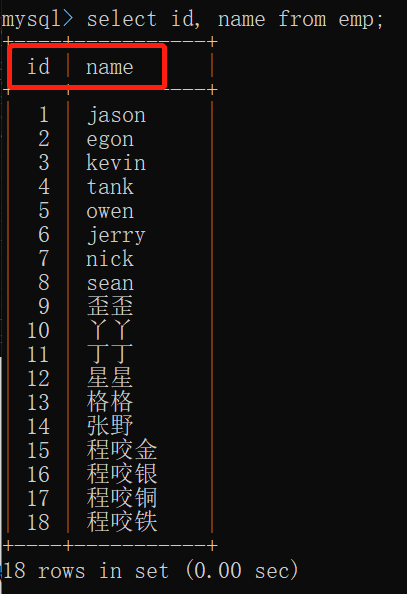
1.2 where
约束条件
例子用法:
# 1.查询 id 大于等于 3 小于等于 6 的数据
select id, name from emp where id >= 3 and id <= 6; # 与下面的 sql 语句等价
select * from emp where id between 3 and 6; # 结果如下:
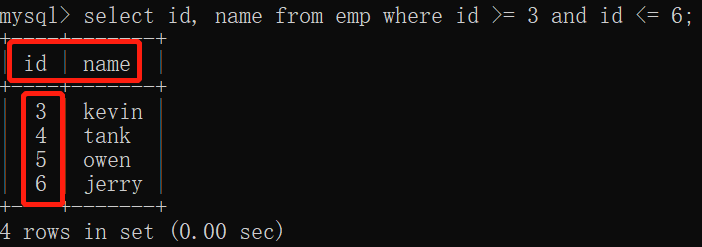
# 2.查询薪资是 20000 或者 18000 或者 17000 的数据
select * from emp where salary = 20000 or salary = 18000 or salary = 17000;
# 与下面的 sql 语句等价
select * from emp where salary in (20000,18000,17000); #结果如下:

# 3.查询员工姓名中包含 o 字母的员工姓名和薪资
select name, salary from emp where name like '%o%';
%可以匹配多个字符 # 结果如下:

# 4.查询员工姓名是由四个字符组成的员工姓名与其薪资
select name, salary from emp where name like '____'; # 与下面的 sql 语句等价
一个_下划线匹配一个字符,四个就固定匹配4个
select name, salary from emp where char_length(name) = 4; # 结果如下
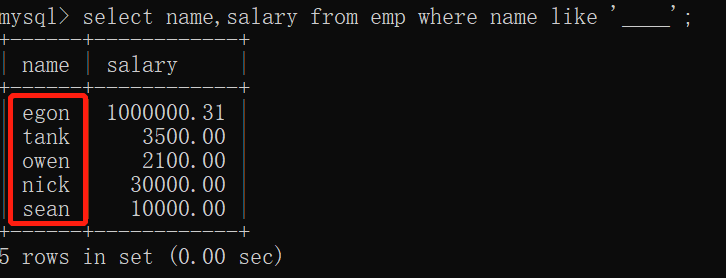
# 5.查询 id 小于 3 或者大于 6 的数据
select * from emp where id < 3 or id > 6; # 与下面的 sql 语句等价
select * from emp where id not between 3 and 6; # 结果如下:

# 6.查询薪资不在 20000,18000,17000 范围的数据
select * from emp where salary not in (20000,18000,17000); # 结果如下:

# 7.查询岗位描述为空的员工名与岗位名
select name, post from emp where post_comment = NULL; # 报错 Empty set (0.00 sec)
针对 null 不能用等号,只能用 is
select name, post from emp where post_comment is NULL; # 结果如下
由于在添加记录的时候所有 post_comment 都是 null ,所以全部都匹配到了

1.3 group by
数据分组,后面接分组依据(字段名)
例子用法:
# 1.按部门分组
select * from emp group by post; # 分组后取出的是每个组的第一条数据

不应该在去取组里面的单个元素的值,那样的话分组就没有意义了,因为不分组就是对单个元素信息的随意获取
设置 sql_mode 为 only_full_group_by ,意味着以后但凡分组,只能取到分组的数据
set global sql_mode="strict_trans_tables,only_full_group_by"; # 重新链接客户端

再次尝试:select * from emp group by post; # 报错
![]()
# 强调:只要分组了,就不能够再“直接”查找到单个数据信息了,只能获取到组名
# 2.获取每个部门的最高工资
select post, max(salary) from emp group by post;

# 每个部门的最低工资
select post, min(salary) from emp group by post;

# 每个部门的平均工资
select post, avg(salary) from emp group by post;

# 每个部门的工资总和
select post, sum(salary) from emp group by post;

# 每个部门的人数
select post, count(id) from emp group by post;
# count() 里面的参数可以是任意不为Null的字段名,一般我们使用 id 这个主键来进行计数
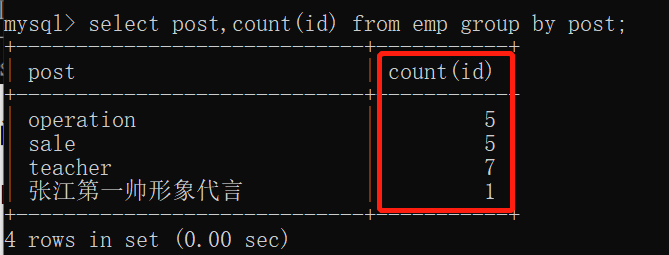
以上的 max min avg sum count 都是聚合函数 >>> 聚合查询(聚集到一起合成为一个结果)
: 以组为单位统计组内数据
# 3.查询分组之后的部门名称和每个部门下所有的学生姓名
# group_concat(分组之后用)不仅可以用来显示除分组外字段还有拼接字符串的作用 支持同时选择多个
select post, group_concat(name,": ",salary) from emp group by post;

# 4.补充 concat(不分组时用)拼接字符串达到更好的显示效果
select concat("NAME: ",name) as '姓名',concat("SAL: ",salary) as '薪资' from emp;
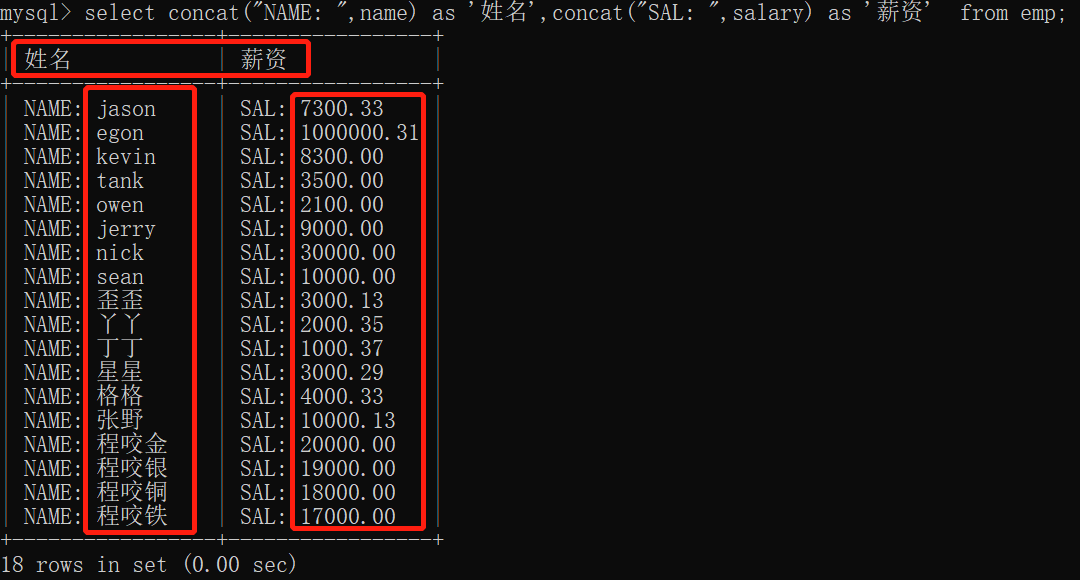
# 5. 补充as语法 即可以给字段起别名也可以给表起
select emp.id, emp.name from emp as t1; # 报错 因为表名已经被你改成了t1
select t1.name as '优秀学生名字', t1.salary as '薪资' from emp as t1 where id = 3;

# 6.查询四则运算
select post as '部门', group_concat(name,':',salary*12) as '年薪' from emp group by post;
# as可以省略,但是不推荐

# 7.统计各部门年龄在30岁以上的员工平均工资
select post, avg(salary) from emp where age > 30 group by post;
# 对where过滤出来的虚拟表进行一个分组 结果如下:

#### 练习题 ```mysql # 刚开始查询表,一定要按照最基本的步骤,先确定是哪张表,再确定查这张表也没有限制条件,再确定是否需要分类,最后再确定需要什么字段对应的信息 1. 查询岗位名以及岗位包含的所有员工名字 2. 查询岗位名以及各岗位内包含的员工个数 3. 查询公司内男员工和女员工的个数 4. 查询岗位名以及各岗位的平均薪资 5. 查询岗位名以及各岗位的最高薪资 6. 查询岗位名以及各岗位的最低薪资 7. 查询男员工与男员工的平均薪资,女员工与女员工的平均薪资 """ 参考答案: select post,group_concat(name) from emp group by post; select post,count(id) from emp group by post; select sex,count(id) from employee group by sex; select post,avg(salary) from emp group by post; select post,max(salary) from employee group by post; select post,min(salary) from employee group by post; select sex,avg(salary) from employee group by sex; """
小结: 关键字 where group by 同时出现的情况下,group by 必须在 where 之后
where 先对整张表进行一次筛选,然后group by再对筛选过后的表进行分组
如何验证 where 是在 group by 之前执行而不是之后;利用聚合函数,因为聚合函数只能在分组之后才能使用
select id, name, age from emp where max(salary) > 3000; # 报错!
select max(salary) from emp;
正常运行,不分组意味着每一个人都是一组,等运行到 max(salary) 的时候已经经过 where,group by 操作了
1.4 having
having 的语法格式与 where 一致,只不过 having 是在分组之后进行的过滤
即 where 虽然不能用聚合函数,但是having可以!
#强调:having必须在group by后面使用 换而言之:必须出现 group by 以后才能使用 having
select * from emp having avg(salary) > 10000; # 报错
例子用法:
# 统计各部门年龄在 30 岁以上的员工平均工资,并且保留平均工资大于 10000 的部门
select post, avg(salary) from emp where age >= 30 group by post having avg(salary) > 10000;

1.5 distinct
对 有重复 的展示数据进行 去重操作
例子用法:select distinct post from emp; # 结果如下:

1.6 order by
作用:排序
例子用法:
#1. 按照薪资升序
select * from emp order by salary asc; # asc不写默认升序

# 2.按照薪资降序
select * from emp order by salary desc; # 降序排

# 3.先按照 age 降序排,在年纪相同的情况下再按照薪资升序排
select * from emp order by age desc, salary asc; 中间是逗号!!!!不是 and

# 4.统计各部门年龄在 10 岁以上的员工平均工资,并且保留平均工资大于 1000 的部门,然后对平均工资进行排序
select post as '部门', avg(salary) as '平均工资' from emp
where age > 10 group by post having avg(salary) > 1000 order by avg(salary) asc;

1.7 limit
限制展示条数
例子用法:
# 1.查询表中前三条数据
select * from emp limit 3; # 结果如下:

# 2.查询工资最高的人的详细信息
select * from emp order by salary desc limit 1;
先对薪资进行降序排列,然后取第一条数据 # 结果如下:

# 3.补充用法
select * from emp limit 10,5;
第一个参数表示 起始位置,第二个参数表示的是 条数,不是索引位置 # 结果如下:

1.8 正则
例子:select * from emp where name regexp '^j.*(n|y)$';
正则匹配内容为:以j开头,以n或y结尾,中间匹配0到多个不为换行符的内容
如: jjjjjn jssssssssn jdery jy jn 等都可以匹配到 # 结果如下:

2. 多表查询
前期表准备:
#建表 create table dep( id int, name varchar(20) ); create table emp( id int primary key auto_increment, name varchar(20), sex enum('male','female') not null default 'male', age int, dep_id int ); #插入数据 insert into dep values (200,'技术'), (201,'人力资源'), (202,'销售'), (203,'运营'); insert into emp(name,sex,age,dep_id) values ('jason','male',18,200), ('egon','female',48,201), ('kevin','male',38,201), ('nick','female',28,202), ('owen','male',18,200), ('jerry','female',18,204);
创建完以后如下所示:

2.1 表查询
硬盘上是多张表,到 内存 中应该把他们 拼成一张表 进行查询
select * from emp,dep; 得不到有效信息
# 左表一条记录与右表所有记录都对应一遍 >>> 笛卡尔积
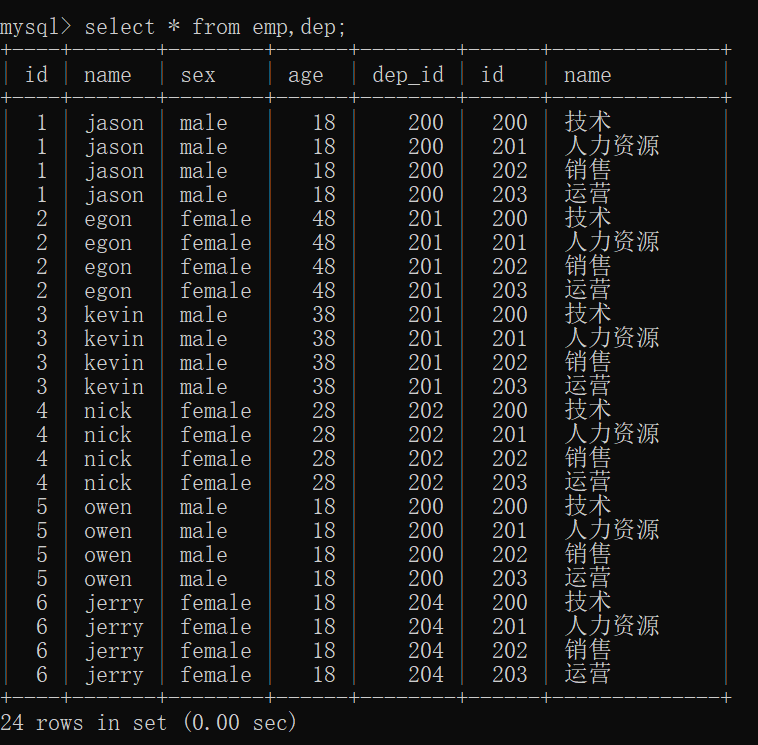
虽然不合理但是其中有合理的数据,现在我们需要做的就是找出合理的数据
# 查询员工及所在部门的信息
select * from emp, dep where emp.dep_id = dep.id;
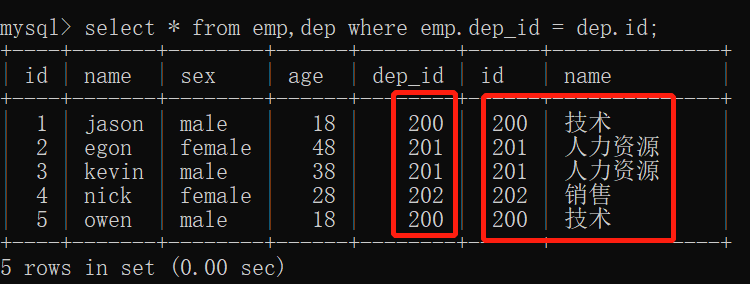
# 查询部门为技术部的员工及部门信息
select * from emp, dep where emp.dep_id = dep.id and dep.name = '技术';

####################################################
# 将两张表关联到一起的操作,有专门对应的方法:
1、内连接:只取两张表有对应关系的记录
select * from emp inner join dep on emp.dep_id = dep.id;
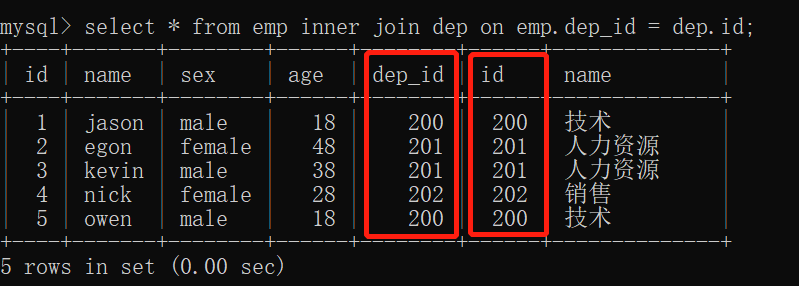
2、左连接: 在内连接的基础上保留左表没有对应关系的记录
select * from emp left join dep on emp.dep_id = dep.id;

3、右连接: 在内连接的基础上保留右表没有对应关系的记录
select * from emp right join dep on emp.dep_id = dep.id;
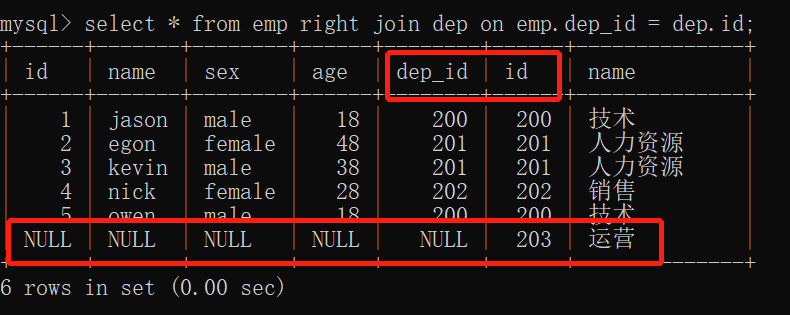
4、全连接:在内连接的基础上保留左、右面表没有对应关系的的记录
select * from emp left join dep on emp.dep_id = dep.id
union # 注意:这是一句话
select * from emp right join dep on emp.dep_id = dep.id;

#############################################################
2.2 子查询
就是将一个查询语句的 结果用括号括起来 当作另外一个查询语句的 条件 去用
例子用法:
# 1.查询部门是技术或者人力资源的员工信息
select * from emp where dep_id
in (select id from dep where name = "技术" or name = "人力资源");

# 2.每个部门最新入职的员工 # 第一次创建的表中数据
思路:先查每个部门最新入职的员工,再按部门对应上联表查询
select t1.id, t1.name, t1.hire_date, t1.post, t2.* from emp as t1
inner join
(select post, max(hire_date) as max_date from emp group by post) as t2
on t1.post = t2.post
where t1.hire_date = t2.max_date;

规律:表的查询结果可以作为其他表的查询条件,也可以通过 其别名的方式 把它作为一张虚拟表去跟其他表做关联查询